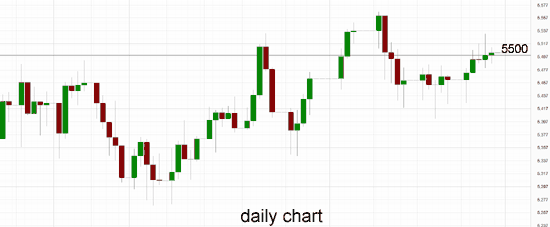Australia 200 Remains Fixated On Key 5500 Level
MarketPulse | May 19, 2014 12:39AM ET
Australia 200 for Monday, May 19, 2014
Over the last month or so the Australia 200 Index has formed an attraction to the key 5500 level. The index has spent a considerable amount of time trading around 5500, although over the last couple of weeks it has been trading below this level. During this time it has been placing ongoing pressure on the resistance level at 5500 and late last week it was finally able to move through to a three week high before easing back again to this key level. Several weeks ago it slowly but surely eased away from its multi-year high achieved near 5560; however, the following week it fell reasonably sharply and started looking towards the 5400 level. In doing so, it returned back under the key 5500 level which has provided some reasonable resistance over the last few months.
For the bulk of the last few months, the Australia 200 Index has traded roughly between 5300 and 5500, therefore its return to back under 5500 was not surprising. The index has done well over the last couple of months to move steadily higher from support around 5300 up to beyond 5500, forming higher peaks and higher troughs along the way. The support level at 5300 may also be called upon should the index fall lower and will also likely play a role in providing some buffer from any decline. Since February, most of the trading activity has occured between 5400 and 5500, therefore the former level may also be called upon to prop up prices. The index has done very well over the last couple of years moving from below 4000 to its present trading levels around 5500.
Making it easier for home buyers to borrow more than they can reasonably service does “nobody a favour,” the Reserve Bank of Australia has warned. As interest rates have fallen, demand from housing investors and trade-up buyers has increased. But first-home buyers will feel squeezed out, which is “probably quite disheartening” for them, head of the RBA’s financial stability department Luci Ellis told a Sydney conference. “As such, it would not be a good outcome if they responded by overstretching themselves to try to get into the market during upswings,” Ms Ellis told the CITI Residential Housing Conference. “As well as being against first home buyers’ own long-run interests, that would increase risk in the financial system.” Overseas experience had shown that making excessive borrowing easier was unhelpful, she said.

Australia200 May 19 at 00:50 GMT 5491 H: 5503 L: 5489
Australia200 Technical
| S3 | S2 | S1 | R1 | R2 | R3 |
| 5400 | 5300 | 5000 | 5500 | --- | --- |
During the hours of the Asian trading session on Monday, the Australia 200 Index is trading right around the key 5500 level as it recently eased back from above 5500. For most of this year, the Australia 200 Index has moved well from the lower support level at 5000 up to the multi-year highs above 5500 ofthe last few weeks.
Further levels in both directions:
• Below: 5400, 5300 and 5000.
• Above: 5500.
Economic Releases
- 22:30 (Sun) NZ BNZ-Business NZ PSI (Apr)
- 23:01 (Sun) UK Rightmove House Price Index (May)
- 23:50 (Sun) JP Key Machinery Orders (Mar)
Original post

Trading in financial instruments and/or cryptocurrencies involves high risks including the risk of losing some, or all, of your investment amount, and may not be suitable for all investors. Prices of cryptocurrencies are extremely volatile and may be affected by external factors such as financial, regulatory or political events. Trading on margin increases the financial risks.
Before deciding to trade in financial instrument or cryptocurrencies you should be fully informed of the risks and costs associated with trading the financial markets, carefully consider your investment objectives, level of experience, and risk appetite, and seek professional advice where needed.
Fusion Media would like to remind you that the data contained in this website is not necessarily real-time nor accurate. The data and prices on the website are not necessarily provided by any market or exchange, but may be provided by market makers, and so prices may not be accurate and may differ from the actual price at any given market, meaning prices are indicative and not appropriate for trading purposes. Fusion Media and any provider of the data contained in this website will not accept liability for any loss or damage as a result of your trading, or your reliance on the information contained within this website.
It is prohibited to use, store, reproduce, display, modify, transmit or distribute the data contained in this website without the explicit prior written permission of Fusion Media and/or the data provider. All intellectual property rights are reserved by the providers and/or the exchange providing the data contained in this website.
Fusion Media may be compensated by the advertisers that appear on the website, based on your interaction with the advertisements or advertisers.